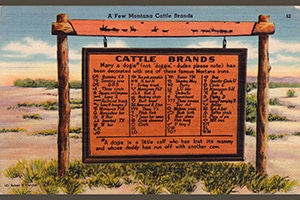Dating as far back as 2700 BC, the act of branding livestock became a way of marking ownership by using fire heated objects to inflict a symbol, design or term on a living creature to show ownership. Hieroglyphics found in Egyptian tombs depict pictures of oxen being branded. Ancient Romans were said to choose certain symbols in their branding as a way to place magic over the livestock for protective purposes.
As time evolved, areas such as Spain that had large quantities of cattle used branding to allow the different herds to intermingle while grazing. The idea was brought into North America as a European custom and continued to evolve by the vaquero tradition in the Southwest and Northern Mexico.
As the branding system was adopted by the American West, ranchers came up with the idea to use a metal rod with a symbol attached to the end and the branding iron was invented. With numerous cattle grazing on the open range, branding became a reliable way to separate cattle owned by different ranches when it was time to move them to stockyards or rail yards, on their way to market.
Branding cattle was also a technique to deter cattle rustlers, although thieves became skilled at changing brands to cover up their stolen goods. Since brands became so numerous, a system was needed to record them, and soon laws were passed that required livestock owners to record their brands. Pocket books were carried by ranchers so they could identify their cattle. Cattle would be checked when they passed through different territories to make sure they had a bill of sale consistent with the brands recorded. Acting as trademarks, brands were also a way to regulate and impose taxes.
With the many branding options to choose from it became a work of art to create an authentic brand. With ranchers using simple letters and numbers with a symbol, styles were incorporated by changing the way the letter or symbol looked and were then labeled as lazy, crazy, flying and walking. The location of the brand on the animal also helped determine which ranch the animal came from. The left hip was the customary location for the brand. The vote is still out on exactly why, but some cowboys claim the left side is more visible for right-handed ropers and that cattle tend to mill to the left more frequently making it easier to read brands in sale rings.
With a long history of branding behind us, today the practice is still in full swing for many of the same reasons it was originally created. Even though more sophisticated techniques have been invented to keep track of cattle such as GPS tagging and DNA testing, branding cattle still comes out on top as the most effective way to battle thieves and fraud. With the most effective brands being the simplest and less impact on the cattle, it seems that branding livestock will continue on as a ranching tradition for years to come.

